Once Freya was settled in (a few cuddles aiding), we decided we could go out for a walk and a bus ride.

King Lud, mythical founder of London
We passed through Ludgate Circus where this handsome head, representing King Lud, the mythical founder of London, appears on the building that was once a pub called Old King Lud, founded in 1870. Today it is no longer a pub, being shared between a bank and a cafe.

Plaque to the Daily Courant (1702)
Beside the building, this plaque reminds us that the first English regular daily newspaper, the Daily Courant, was published in a house nearby from 1702.
Two buses brought us here, to Poplar. This building is one of those belonging to the Robin Gardens estate, built in the 1970s. Some people (people who don’t actually have to live here) want it listed and preserved, whereas the Council wants to demolish it. It seems that a majority of the residents would be glad to see the back of it too. English Heritage opposes listing and that should count for something, I think.
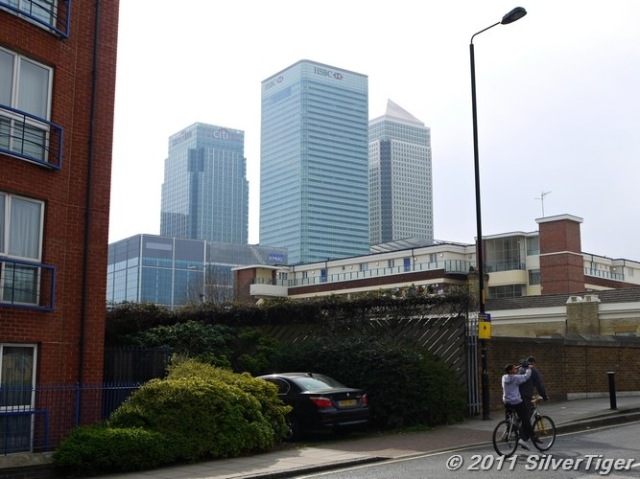
Canary Wharf overshadows Poplar
Poplar grew up as the docks developed and people came into the area in search of work or brought by incoming shipping. By the end of the 19th century, the area was overcrowded and poverty stricken. It suffered badly from enemy action in the Second World War. Today, most living accommodation is council housing.
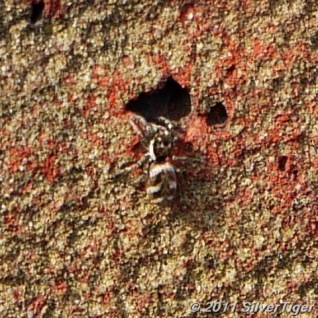



A spider explores a hole in a brick wall
In a contrast to the towering housing blocks, we watched this tiny spider exploring a hole in a brick wall, perhaps seeking a nesting site.
As Poplar grew, so the need for a parish church was felt. All Saints was built of Portland stone in the early 1820s to a plan by Hollis which includes an Ionic portico and a Wren-style steeple.

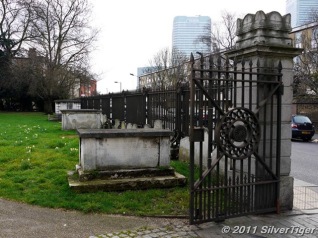
The robust railings of All Saints
The commodious grounds are surrounded by a robust and well designed set of railings. I don’t know whether these are original or are replacements (they seem held together by modern bolts).
Poplar Baths opened in 1852 and the building was used not only as a baths but also for dancing and other entertainments. Sadly, today it lies closed and derelict, despite being listed since 2001. A plan was passed by the Council in March 2010 to renovate and reopen the baths. Will this plan ever be realized?
In front of the baths stands this monument to Richard Green, 1803 to 1863. Scion of a business family, Green entered the family firm and later became a ship builder and ship owner, operating from the East India Docks.
Green’s philanthropic works include support for children’s education and improvement of conditions at sea. He endowed the Sailors’ Home at Poplar, the Merchant Seamen’s Orphan Asylum in East London and the Dreadnought Seaman’s Hospital at Greenwich and many other projects.



Richard Green and the side panels
The sculpture was created by Edward W. Wyon in 1865 and the monument set up in 1866. Two bronze side panels reflect Green’s shipping interests. The dog adds a pleasant informal quality to the piece.

Ceci n’est pas une bibliothèque
(It’s an Ideas Store)
Further down Chrisp Street are shops and this building. Don’t mention the ‘L’ word, for though it may look like a public library, behave like a public library and provide the functions of a public library, it isn’t a public library: it’s an Ideas Store. Allegedly.
Having worked in the public library myself, I would have complimented this one its design and amenities. I think I would have quite liked to work there had I still been in the business. The only (small) criticism I have is that the olive green decor makes the place a little too dark for complete comfort.
I could perhaps have entitled this post “Both ends of the Blackwall Tunnel”. That is because the famous tunnel that carries traffic under the Thames has one end in Poplar (at Blackwall, as the name suggests) and the other end here, where we came next. Can you guess what the cables on the left of the picture are supporting?
They are supporting cables of this icon of British organizational, managerial and financial incompetence, the Millennium Dome, which has rendered the government of the day the laughing stock of Europe. The best that can be said of it is that its building at least caused a clean-up of this previously dangerously polluted site.
The buildings along here are not bad as modern architecture goes and we particularly liked the black and white tiled one (see above) which, according to the designers, was inspired by the work of mathematician and philosopher Roger Penrose’s work on tessellations.
Leaving the Dome and other buildings behind, we took to the riverside walk. There were very few people about and it was pleasant despite the cold. There were also some interesting sights along the way.
This metal tree makes a striking and startling sight. Behind it is a mooring of the Thames Clipper service. (See Riding the Thames.)
This piece, called Slice of Reality, is literally a slice through a ship. The artist is Richard Wilson.

Old jetty, now a wildlife sanctuary
This structure, once a working jetty, is now closed off and has been turned into a wildlife sanctuary.
You may be able to see that the projecting boom in the above photo is matched by one on the jetty. The line they indicate is the longitude of Greenwich, the zero meridian line from which longitude around the world is usually measured. The line is marked right across the whole site.

Famous silhouettes against the sinking sun
The view from the waterside is very different from what it would have been when the docks were active and London was the busiest port in the world. Today it is still frantically busy but the work is done inside tall office buildings and the scene along the banks is quiet and peaceful. There is always something strangely fascinating about light shimmering on the water.
We took a final look across to the north bank at Canary Wharf and its giant companions, dwarfing the older buildings and apartment blocks at water’s edge. A tube train carried us under the river to Canary Wharf (Isle of Dogs) then under the river again to Canada Water. Here we took the Overground to Highbury & Islington and then the bus back to the Angel.
Poplar and the Greenwich Peninsula are very different worlds despite being linked by the Blackwall Tunnel. In the past, they would have shared more, I think, when the great ships came here to disgorge merchandise from all over the world.
Copyright © 2011 SilverTiger, https://tigergrowl.wordpress.com, All rights reserved.



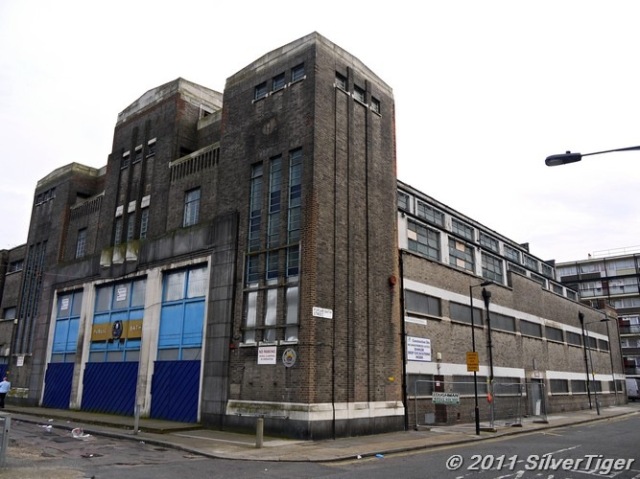
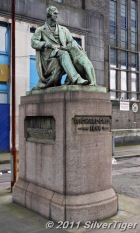

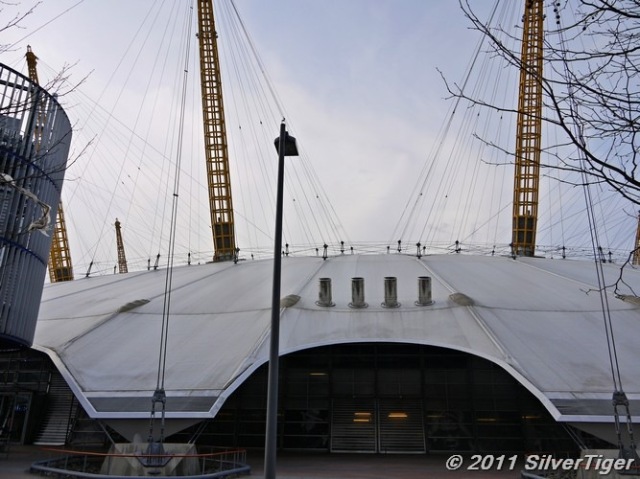
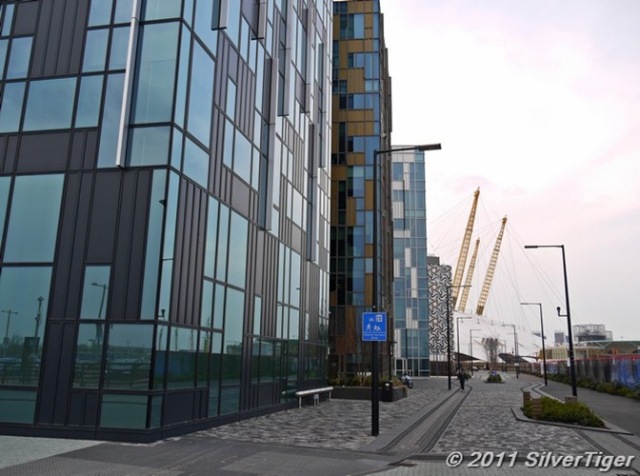



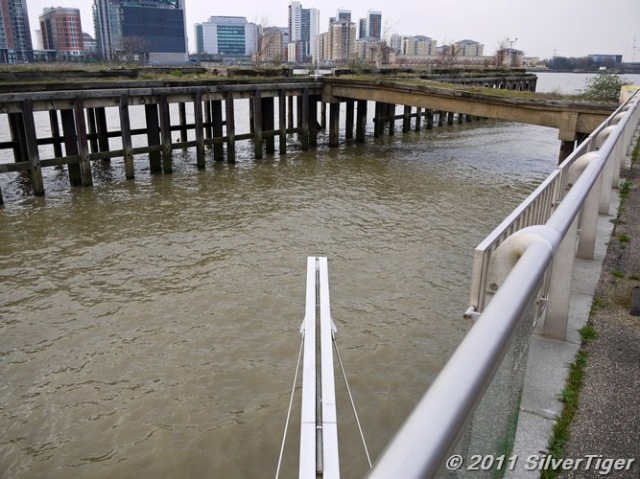
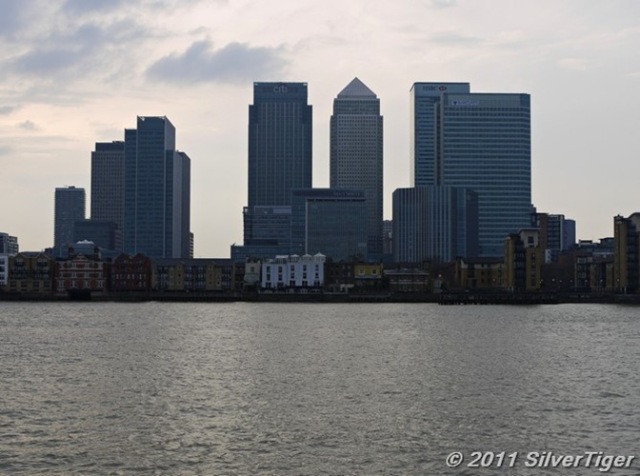



I’ve never cared for the Millenium Dome, myself. It looks like a collapsed circus tent to me. However I agree with you that the tessilatged black and white building is very interesting. I am having trouble working out what those “ponds” are in front of it. Are they some kind of fountain pools — maybe bubbling instead of “founting?” The dog in the statue of Richard Green may be meant to “humanize” him, or it may be he was a well-known dog lover, or this was a beloved pet. It is an interesting pose — looks like he was lifted out of a drawing room and plunked down on a plinth. — has he flipped the tails of his coat over the back of the chair? “Canary Warf” made me laugh. In the revived Doctor Who series, there was a “famous” battle that occured there between the Daleks, the Cybermen and humans for control of the Earth.
LikeLike
I call the Millennium Dome “the Cowpat” because that’s what it resembles. As you say, it looks as if it’s collapsing.
Those water features are shallow ponds (shallow because otherwise some idiot will go and drown himself) with holes arranged in a square through white water and air bubbles up, causing the water to foam. The charm of water usually lies in its movement and this is difficult or impossible to capture in a still photo.
I don’t know whether Richard Green was a dog lover. The sculpture suggests as much.
The coat does indeed seem to be spread over the back and arms of the chair. This reminds me of how pianists in tail-coats flip the tails back as the sit down on the piano stool. It’s obviously intended to avoid creasing the coat by sitting on it. The pose is less formal than many of the period and all the more attractive for it.
Canary Wharf is, strictly speaking, the building with the pyramidal roof. It has become an icon for the the redevelopment of the docks area. I find there is something alien about Docklands, as if one has stepped onto the set of a sci-fi movie. It’s big but it doesn’t feel real. It’s arid and inhuman. Maybe we need to give it a couple of hundred years to settle in.
LikeLike